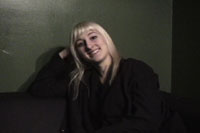Wooley/Corsano/Yeh, "Seven Storey Mountain"
 This is the second installment of Nate Wooley's wonderfully uncategorizable improvisation project based upon a fixed backdrop of abstract tape recordings.  Notably, it sounds radically different than the skittering and nightmarish first album (where Wooley was joined by Paul Lytton and David Grubbs) and continues to betray no hint of Wooley's background as a jazz trumpeter.  This is improvised music at its most difficult and listener-unfriendly, alternating between queasily dissonant droning and explosive catharsis.  I like it, but it is very much pure, uncompromising art without any nod to accessibility.
This is the second installment of Nate Wooley's wonderfully uncategorizable improvisation project based upon a fixed backdrop of abstract tape recordings.  Notably, it sounds radically different than the skittering and nightmarish first album (where Wooley was joined by Paul Lytton and David Grubbs) and continues to betray no hint of Wooley's background as a jazz trumpeter.  This is improvised music at its most difficult and listener-unfriendly, alternating between queasily dissonant droning and explosive catharsis.  I like it, but it is very much pure, uncompromising art without any nod to accessibility.
This performance, recorded in 2009, is a confounding and expectation-subverting one in many ways.  Even its very title initially puzzled me, as it unambiguously references Thomas Merton's autobiographical account of his spiritual journey towards becoming a Trappist monk.  There is nothing about this piece (or its predecessor) that says "quest for inner peace" or "religious ecstasy"– quite the contrary, in fact.  Instead, the mood is rather seething, haunted, and disturbed, as Wooley's true inspiration is a bit less obvious: the honesty, fear, and struggle of Merton's actual life.  In retrospect, that seems appropriate, as Nate avoids obviousness in every possible respect here (to an almost pathological degree).
The most significant idiosyncrasies come from Wooley's compositional structure and trumpet playing.  For one, Wooley doesn't just play the trumpet in an unusual way here, he plays it in an entirely unrecognizable way.  He manages, as near as I can tell, to avoid playing a single note in the traditional sense for the piece's entire 42-minute duration.  Instead, he uses contact mics to amplify his breathing and valve manipulation and to create feedback.  Also, the piece's backbone–the tapes–seem to be cut from the same cloth, which seems like a very bizarre and minimal structure to repeatedly base a lengthy performance upon (lots of hissing, scrape-like sounds, and understated hums).  It is nearly impossible to tell what is live and what is prerecorded.  It works, mind you, but it is difficult for me to understand the mental process behind it, though I certainly admire its daring.
Given that he is the only one playing a conventionally melodic instrument, C. Spencer Yeh's violin seems to drive the piece by default.  At first, he restrains himself to long droning notes that harmonize uncomfortably with Wooley's drifting feedback, but the piece gradually escalates into something resembling a marauding flock of inebriated seagulls backed by Chris Corsano's somewhat muted drum flurries. The piece seems to truly catch fire around the halfway mark, as Yeh's seagull attack is gradually bolstered by layers of low tormented moans, vicious bow scrapes, shrill air raid siren swoops,  feedback squalls, and an increasingly frenzied and cymbal-heavy Corsano.  There is no one better to have around for roiling, clattering cacophony than Chris Corsano.
Gradually, all the chaos subsides and the piece ends with drifting, uncomfortably harmonized drones and lazily repeating feedback buzz and hiss (but not before one spectacular and unexpected blast of stuttering, spacey sounding feedback and cavernous breathing noises).  It makes a fine denouement to the prolonged and visceral white-hot climax that preceded it.  Of course, the piece is not without some notable flaws (the first half drags a bit, it is markedly less compelling without headphones and focused listening, etc.), but they are very easy to forget once the trio hits their full momentum.  This definitely required a lot of patience, attention, and tolerance for dissonant harmony to fully grasp and appreciate (more than the 2009 version, I think), but it was ultimately well-worth it.  Wooley has birthed something unique and impressive.
Samples:
 



